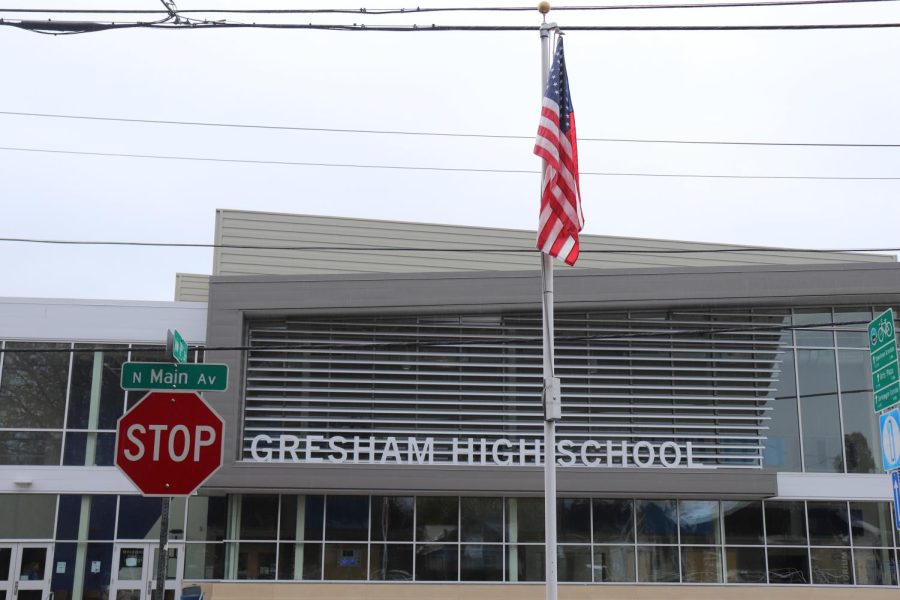Why stand for the Pledge of Allegiance: strength through community
April 16, 2022
As the morning bell rings, students relax while the morning announcements are shared during 2nd period. Some students smile while others are unsure of the day ahead or others around them. Yet, when the announcements pause and the infamous phrase: “Please stand for the Pledge of Allegiance” begins, there is at times, a sort of tension in the room; an uncomfortable silence.
As the pledge is recited, one can feel the silent judging of both sides: For those who stand and recite, and those who sit. With the recitation of the Pledge of Allegiance in the announcements returning to the school in 2022, it has undoubtedly sparked controversy and political tension; a stark contrast to the American unity it was intended to invoke.
As with the mask mandates, and the infamous removal of our S.R.O officer. The GHS student body is divided once again; with some student groups completely discrediting the pledge, describing its contents as “not inclusive” and “white nationalism,” as a representative for the S.A.O Instagram account said.
In spite of these accusations, the pledge still stands firm; not to offend nor alienate others, but to invoke pride in American identity, and all of its core values. This includes the First Amendment, which covers the freedom of expression and religion, hence its participation being optional.
The U.S is a melting pot of different cultures, races, and ethnicities. Whether it’s Chinatown, black culture, or how most automated school messages are repeated in Spanish to accommodate the Latin-American community, there’s no denying that the U.S is culturally diverse, and thus as citizens, are covered by the pledge itself: further breaking down the claim that the pledge excludes the colored and upholds white-nationalism.
As a colored person, however, I’m not blind to America’s racist past, as well as the pledge’s questionable origins. It was written in 1892 by Francis Bellamy.
Bellamy, a Christian socialist and editor of the Youth Companion newspaper, had originally written the pledge to encourage patriotism, and celebrate the 200th year of Christopher Columbus’s arrival. However, according to Catherine Caruso of TeenVOGUE, Bellamy was a staunch opponent of immigration. He believed, “immigrants were of an inferior race,” and “a threat to traditional American values”.
Caruso believes “The Pledge of Allegiance is a forced display of patriotism rooted in nativism, bigotry, and salesmanship”.
Caruso’s article ignores the cultural and traditional value that the pledge itself holds, and mainly focuses on the original creator despite how the pledge has changed since then: both literally, and symbolically. For instance, consider that the pledge itself has been around for hundreds of years, and its main intent is to salute the flag and instill unity and community; things that anyone of any age can learn if they choose to participate.
While it’s true that America has had a racist past and still has its share today, the notion that the pledge’s purpose is still to uphold white nationalism is both outdated and dangerous to preserving the social fabric and culture of our nation. Since October of 1892, it’s been customary to salute the flag. It honors our home and its inhabitants; including immigrants and minorities like myself, and everything our veterans have fought for. From The American Revolution to WWII & the Middle East, many have forgotten that freedom is never free. Freedom is won through the blood, heart, and willpower of the protective and brave.
As famous writer & philosopher, G.K Chesterton once said, “the true soldier fights not because he hates what is in front of him, but because he loves what is behind him.” Love for the homeland has always been universal to those who care, and while we’ve had a long history of distrusting governments, an ideal American would never hate America herself, as doing so would be to hate oneself and their kin. This is our homeland, and we are all part of it.
Like pieces to a puzzle, the people have a role to play in shaping society, and so it’s in the youth’s interest to consider switching our social views from lenses of race, to lenses of nationality as American citizens. As such, people must understand that when the pledge says “with liberty and justice for all,” it was made to turn the goals of liberty and justice for all, into reality. The pledge represents this common goal we have as Americans and what we should all strive to achieve as a part of our shared sense of national values.
Although the idea that American racism invalidates the pledge should be remembered, and considered in its whole, one could argue that it is for those very same reasons that people; especially those of color, should recite the pledge of allegiance. Together we can make America’s goals of liberty and justice for all into a reality with patience and solidarity just a little bit, day by day, through respect, accountability, and a sense of a national community through shared national values like individualism in spite of smaller differences like race or religion.
As famous black spokesman Malcolm X once said: “A man who stands for nothing will fall for anything”. The pledge gives Americans a chance to stand for something. Likewise, I too choose to stand for freedom, because despite being mixed Austronesian in heritage or having cheeky eyes and foreign tongues, I’m still an American by love, drive, heart, childhood, and most importantly: by pledge! It’s the American dream I’m living, we all struggle with adversity, but sometimes it’s easier to struggle when we stand together, and if not, then what does America stand for?
